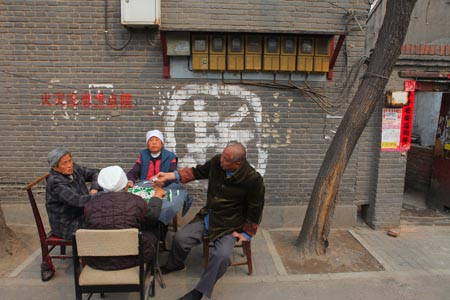Historical residence spared demolition
The local government of Xicheng district, Beijing, has dismissed earlier news reports that the house of Liang Qichao, a renowned Qing Dynasty (1644-1911) reformist, is to be demolished.
 |
|
Four local residents play mahjong in front of a house at Panjia Hutong, 100 meters away from Liang Qichao's yard. The houses have been scheduled for imminent demolition. |
The Information Office of the Xicheng district announced Wednesday that the No. 115 courtyard, the site of the Xinhui Assembly Hall where Liang lived for a short period during the 1890s, would be preserved as a historical site and not demolished, according to a Xinhua News Agency report.
The former Xuanwu district declared in 2009 that the Fenfang area should be spared from demolition due to its historical value. The Beijing News reported Wednesday that the Xinhui Courtyard faced probable demolition.
The announcement said that some other houses neighboring the No. 115 courtyard in the Fenfang area, which do not have historical value, would be demolished according to a plan drawn up in 2009.
The Fenfang area consists of three hutong, namely Fenfang Liulijie Hutong, Panjia Hutong and Beitangzi Hutong. Before the People's Republic of China was founded, about 30 assembly halls were located in the area, said Liu Zheng, a China Cultural Relics Association member who has studied the area.
The Fenfang community was built during the Ming Dynasty (1368-1644) and became famous for accommodating petitioners who tried to bring appeals to Qing Dynasty rulers.
Liang Qichao, a Qing Dynasty reformist who inspired Chinese scholars with his writings, spent about three years in the No. 115 courtyard, which is located at the south entrance of Fenfang Liulijie Hutong.
"It was also the place where he got married," Liu said.
According to Liu, the Fenfang area had been slated for demolition to make way for a real estate project called "CITIC City." Many of the houses built along the hutong have already been demolished.
 0
0 






